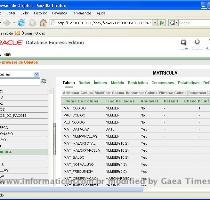Stocks set to extend September rally after strong results from Oracle, Research in Motion
By Stephen Bernard, APFriday, September 17, 2010
Stock futures jump on strength in tech sector
NEW YORK — New signs of strength in the technology sector drove stock futures higher Friday.
Futures did pare some of their gains after the Organization for Economic Cooperation and Development said the global economy is off to a weaker start in the second half than expected.
But optimism around strong profit reports from BlackBerry maker Research in Motion Ltd. and software company Oracle Corp was enough to overcome the warning from the OECD. Research in Motion also tried to quell unease surrounding ongoing disputes about data security.
Strong revenue growth at Oracle demonstrated that companies are investing in new technology, which is often considered a leading indicator for an economic recovery.
The big gains could be good enough to restart a September rally that has lost some momentum in recent days. September is historically a poor month for stock returns, but this year so far major indexes have climbed sharply as many economic indicators have topped modest growth forecasts.
A report later Friday on consumer sentiment could provide an additional lift to stocks. As reports have indicated continued growth in recent weeks, traders have become more confident the economy will not fall back into a recession.
The Dow Jones industrial average has climbed 10 of the past 12 days and is up 5.8 percent so far this month.
A preliminary reading of the University of Michigan/Reuters sentiment index likely climbed to 70 from 68.9 last month. Rising consumer confidence would bode well for the market because it could lead to a jump in retail sales, a primary driver of the economy.
Ahead of the opening bell, Dow Jones industrial average futures rose 30, or 0.3 percent, to 10,580. Standard & Poor’s 500 index futures rose 3.50, or 0.3 percent, to 1,126.10, while Nasdaq 100 index futures jumped 8.75, or 0.5 percent, to 1,958.50.
Traders will be closely watching the 1,131 level on the S&P 500 because that is the high end of its recent trading range. For traders that make moves based on technical indicators breaking out above that level would indicate the market is ready to extend its rally. Being unable to move significantly above could lead to a sell-off. Many automated trading platforms have buy and sell orders set around such indicators.
There could be added market volatility throughout the day as well because of what is known as “quadruple witching.” It occurs on a day when stock index futures, stock index options, stock options and single stock futures all expire, so volume can pick up as investors settle those contracts.
Oracle reported fiscal first-quarter earnings that easily topped forecasts after the market closed Thursday. Oracle shares jumped 98 cents, or 3.9 percent, to $26.34 in pre-opening trading.
Research in Motion also reported a big jump in earnings as it added new subscribers. An increase in subscribers is also vital because there have been concerns customers were dumping Blackberrys for Apple Inc.’s iPhone and smart phones run on Google Inc.’s Android technology.
Its co-CEO also said he is confident the company will resolve disputes with India, the United Arab Emirates and other countries over data security and avoid threats the service will be banned in those countries. Cutting service in those areas would be a severe blow to Research in Motion’s business.
Research in Motion shares jumped $1.92, or 4.1 percent, to $48.41.
In other corporate news, Johnson & Johnson said it plans to buy Dutch biotechnology firm Crucell NV for $2.29 billion. The move would strengthen Johnson & Johnson’s vaccine business.
Corporate dealmaking has picked up in recent weeks. Deals are a sign that companies are more confident about spending money they’ve held onto during the recession and more optimistic about potential growth in the coming quarters.
Johnson & Johnson rose 5 cents to $61.34.
Even with stocks continuing their rally, safer investments like bonds and gold still remained popular with traders.
Some additional money flowed into Treasurys after the Labor Department said prices at the consumer level rose modestly in August due to higher energy costs. Excluding volatile food and energy prices, inflation showed no increase. That means inflation remains unlikely anytime soon. Inflation hurts bonds because it essentially cuts into returns investors receive on the debt.
The yield on the 10-year Treasury note, which moves opposite its price, fell to 2.71 percent from 2.76 percent late Thursday. Its yield is often used to set interest rates on mortgages and other consumer loans.
Gold touched a new record high again Friday of $1,284.40 an ounce before pulling back to $1,280.70 an ounce.
Overseas, Britain’s FTSE 100 rose 0.2 percent, Germany’s DAX index rose less than 0.1 percent, and France’s CAC-40 climbed 0.2 percent. Japan’s Nikkei stock average rose 1.2 percent.
Tags: Commodity Markets, New York, North America, Prices, Recessions And Depressions, United States



